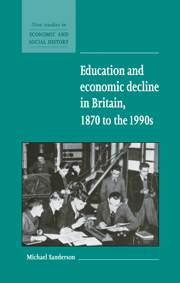Book contents
- Frontmatter
- Contents
- Acknowledgements
- Glossary and abbreviations
- Introduction
- 1 Literacy and schooling, 1870–1914
- 2 Was technical education to blame?
- 3 The counterarguments
- 4 The education of the élite, 1870–1914
- 5 Missed opportunities, 1914–1944
- 6 Post-war decline – the betrayed teenager?
- 7 Higher education and the public schools – privilege and relevance
- Conclusion
- Bibliography
- Index
- New Studies in Economic and Social History
- Studies in Economic and Social History
- Economic History Society
7 - Higher education and the public schools – privilege and relevance
Published online by Cambridge University Press: 05 June 2012
- Frontmatter
- Contents
- Acknowledgements
- Glossary and abbreviations
- Introduction
- 1 Literacy and schooling, 1870–1914
- 2 Was technical education to blame?
- 3 The counterarguments
- 4 The education of the élite, 1870–1914
- 5 Missed opportunities, 1914–1944
- 6 Post-war decline – the betrayed teenager?
- 7 Higher education and the public schools – privilege and relevance
- Conclusion
- Bibliography
- Index
- New Studies in Economic and Social History
- Studies in Economic and Social History
- Economic History Society
Summary
By the end of the second world war, both the universities and the public schools remained institutions with entry restricted to a privileged few, partly by intelligence and to a large extent by wealth. In the post-war years, and especially from the 1960s, both types of institution expanded their intakes. The universities lost much of whatever sense of privilege they had in the move to mass higher education and the public schools, to a much lesser extent, increased their numbers and proportion of the school population. Yet the expansion of the universities and consequent curricular developments raised questions of how far they were becoming less relevant to the needs of an industrial society while the public schools, reviled as anti-industrial before 1914, paradoxically moved closer to the business and industrial world.
In the immediate post-war years there were demands for the expansion of the universities by the Barlow and Percy Reports and others. Although there was not yet the urgent demographic need of the 1960s the number of university students doubled from 50,002 in 1938–9 to 107,699 by 1960–1 as existing universities expanded and were joined by Nottingham, Southampton, Hull, Exeter, Leicester (upgraded from university colleges) and Keele (which was newly founded in 1949 and chartered in 1962). There were also healthy signs that the proportion of students studying science and technology rose from 25.9 per cent in 1938–9 to 40.6 per cent by 1961–2.
- Type
- Chapter
- Information
- Education and Economic Decline in Britain, 1870 to the 1990s , pp. 92 - 104Publisher: Cambridge University PressPrint publication year: 1999



